Review:Audioquest Dragonfly Cobalt: In the summer of 2016, AudioQuest presented the long-awaited successor to the original DragonFly . The surprise was great when not one, but two models came onto the market. The DragonFly Red & Black . In the review of the AudioQues t DragonFly Red there was a clear conclusion: An undisputed winner!
That naturally sets the bar extremely high. Not only for the competition, but also for AudioQuest itself. That is quite a challenge. Is the AudioQuest DragonFly Cobalt really a better audio product than the DragonFly Red? With a price tag of 299 euros, the DragonFly Cobalt has something to prove. Is the DragonFly Cobalt going to hit the bar? Or is he falling short?
DragonFly family
The arrival of the DragonFly Cobalt does not mean that the DragonFly Black & Red will be replaced. Quite the contrary; the youngest member is an addition to the family. This means that the Black & Red are still available. It seems that AudioQuest creates a Good / Better / Best system with this. Of course, the DragonFly Cobalt is the best variant. We think this is a good development, especially when we look at the price structure. The DragonFly Black for 99 euros, Red for 199 and the Cobalt for 299. With this AudioQuest offers better sound in every price range and they do that quite cleverly.
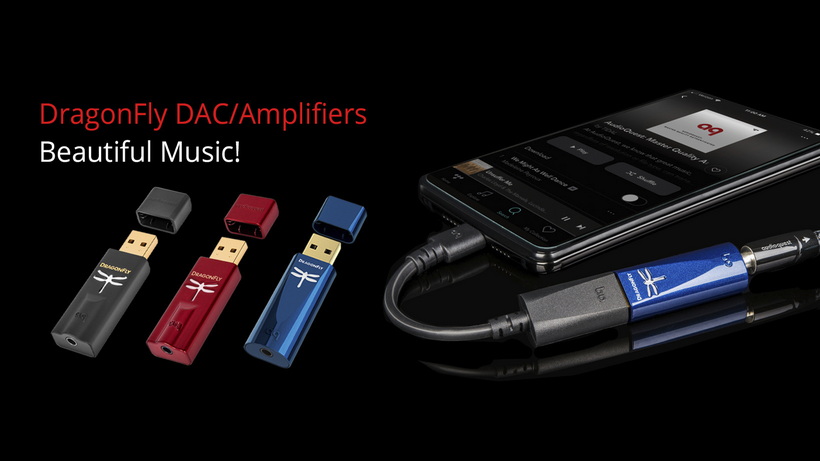
AudioQuest has a specific target audience for the DragonFly models . Mobile listeners in particular want better sound from their smartphone. Laptop users also fall into the target group. It is often also mobile users who miss good sound. For a budget smartphone, the black would already make a world of difference. But the top-end models, such as an iPhone Xs or a Samsung Galaxy Note 10, also want a DragonFly that connects. Nowadays, laptops are increasingly falling into this price range.
The AudioQuest DragonFly Cobalt is slightly more compact compared to the Red & Black. The Cobalt therefore uses a different chip. In the Black we find the ESS 9010 chip and in the Red the ESS 9016. The ESS ES9038Q2M chip was chosen for the Cobalt. AudioQuest has combined this with the PIC32MX274 microprocessor. The aim here has been the pursuit of better sound with less power consumption. But more gains have been made. The power supply has been tackled internally, which would be better protected against unwanted influences from WiFi and Bluetooth, among others. The monoClock technology, with an ultra-low-jitter clock, can also be found inside. By the way, did we mention MQA support and 24-bit / 96khz resolution?
As nice as all these technical details sound on paper, we just want to know whether it is worth the 299 euros for the AudioQuest DragonFly Cobalt.
Mobile hi-fi
Getting on the train with your brand new Brooklyn dac + under your arm to enjoy hi-fi audio quality while on the road is unfortunately not feasible. Nevertheless, AudioQuest has tried to move heaven and earth in order to allow us to enjoy music on the move in that reproduction mode. We accept the challenge and only take the smartphone (Apple iPhone 7) with the DragonFly Cobalt on the road. To maintain the mobile idea, we opt for the Denon C821 in-ears. This also fits well with the price level of the Cobalt.
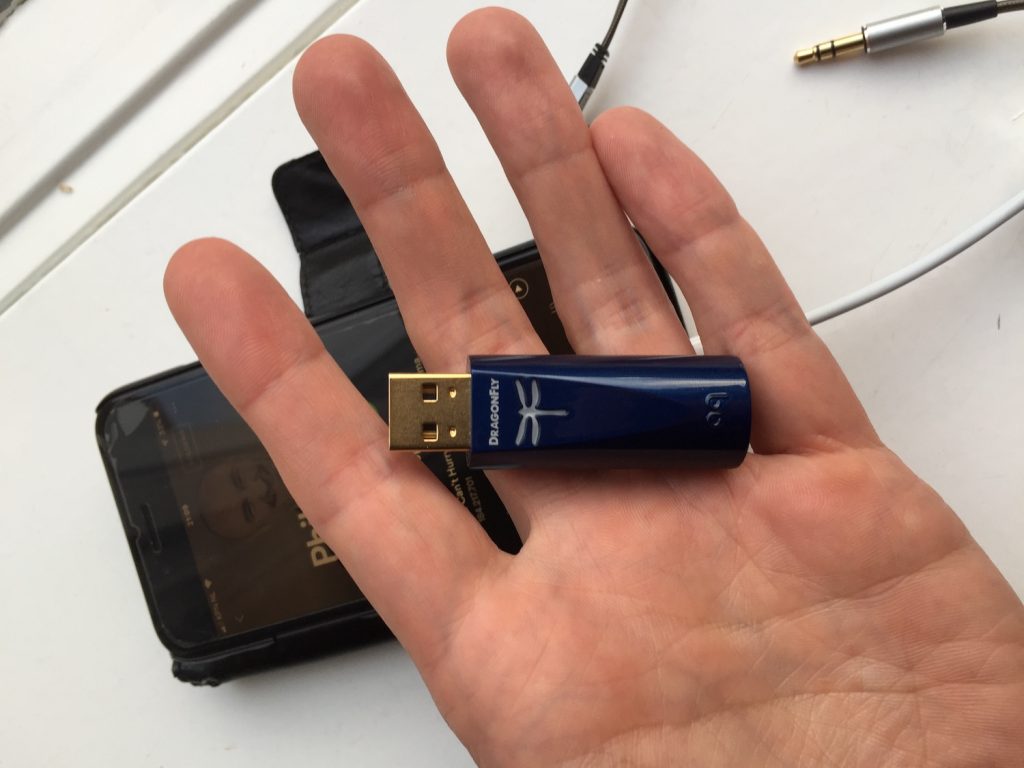
There are a few options for music on the go. We put our favorite music on the phone or we stream the music. The advantage of putting your own music on the phone is that we can play high resolution music. This is also possible with streaming, but then it is very quickly at the expense of the data bundle. We choose to listen via Spotify and Soundcloud. This is also the most realistic. For example, the DragonFly Cobalt could be used daily. Just a point of attention: for Android users an adapter cable is supplied as standard, iOS users will have to purchase this adapter cable themselves.
In the train
To perform the review in a realistic way, we decide to take the train to The Hague on Monday morning with the iPhone, Dragon Cobalt and Denon in-ears. In the middle of rush hour. On Spotify, we choose George Ezra’s latest album. His album Staying at Tamara’s includes the hit Shotgun. The album has a wonderful vibe to start the Monday morning with. It is casual and gives energy to start the tough Monday morning.
It takes some getting used to hanging the DragonFly Cobalt on the phone. That’s how it feels too; there is something on the phone, an extra weight. That includes the reducer. Luckily we managed to get a seat and can answer a few e-mails. The color of the LED on the DragonFly turns green, indicating that the playback quality is 44.1 kHz. When we put the phone in our pocket, the DragonFly dangles from the pocket. We try to stop the DragonFly a bit, but that is still quite a challenge while sitting. The jacket pocket is a better solution here.
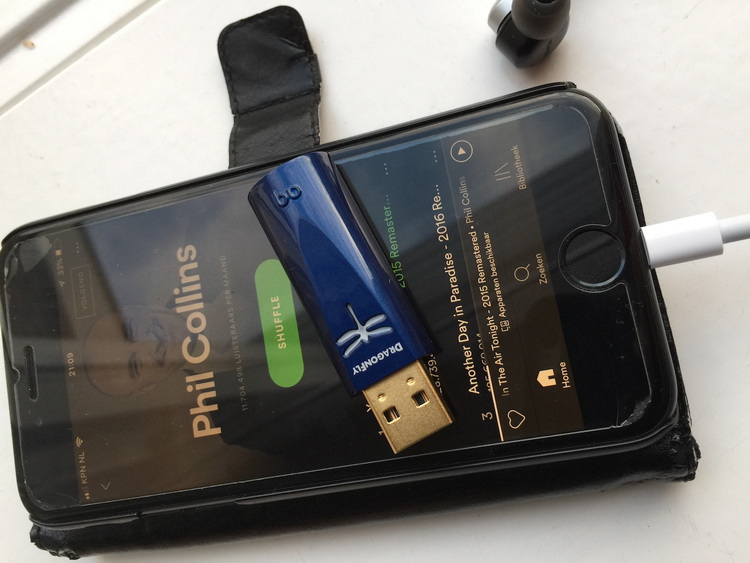
It is truly a heavenly difference when we listen to music with the DragonFly. We switch a few times. Just a song without DragonFly Cobalt and then again with. We did this with Phil Collins – In the air tonight. The music changes immediately with the small dac. We are captivated by the music, it sounds fuller and richer. There is more depth in the low and in the high there is more distinction to be heard. The elements in the music are easier to hear and are placed separately from each other. This creates a beautiful soundstage. There are hi-fi systems that do not reach this level.
To give our Monday morning a boost, we switch to Soundcloud. We listen to the last episode of the Boomroom. Here we are treated to a good helping of EDM and tech house. It is striking that the LED of the DragonFly now turned blue. That meant we were now listening to 48 kHz. Our earlier observation was also confirmed here; there is significantly more distinction between the different elements. The bass is deeper and the soundstage has been placed wide. It is a pure pleasure to be able to travel with this audio quality in your pocket. With Phil Collins we already had the urge to play the air drums very hard, but sitting still with dance music is hopeless. Which is also a very strong point for the DragonFly Cobalt. He literally moves us. The people opposite us had already noticed that, let alone the person sitting next to us. Too bad for them, they should have had a DragonFly.
The hi-fi listening place
We are going to discuss a topic, which may not be immediately obvious. Audiophiles or purists are used to having a great set at home. We can enjoy this at our leisure as soon as we get home. But what if you’re a seasoned professional who works an average of 60 hours a week, not counting travel time? What if you listen to music more on the road and at work than you do at home?
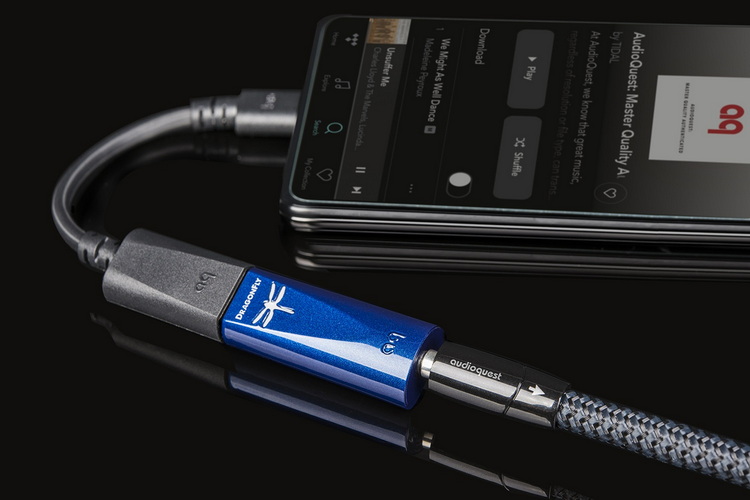
A product such as the DragonFly Cobalt can offer a very good solution here. It offers listeners a combination of mobile hi-fi and an asset to the home. In the morning by bike to the train station the DragonFly Cobalt turns on. Enjoy that good audio quality on the way to work. During the day, the DragonFly Cobalt stays close by.
As soon as the working day is over and you come home late as an audio enthusiast, an active speaker set is a great solution. Consider, for example, the Dali Zensor series. The DragonFly can be very easily taken out of the bag and connected to those speakers. With the right cable that is plug & play. And then there is a hi-fi set playing at home. Combine it with a Tidal subscription and MQA is available. It’s the DragonFly Cobalt that makes a real difference here. It plays at a completely different level than we are used to from mobile DACs.
AudioQuest cover
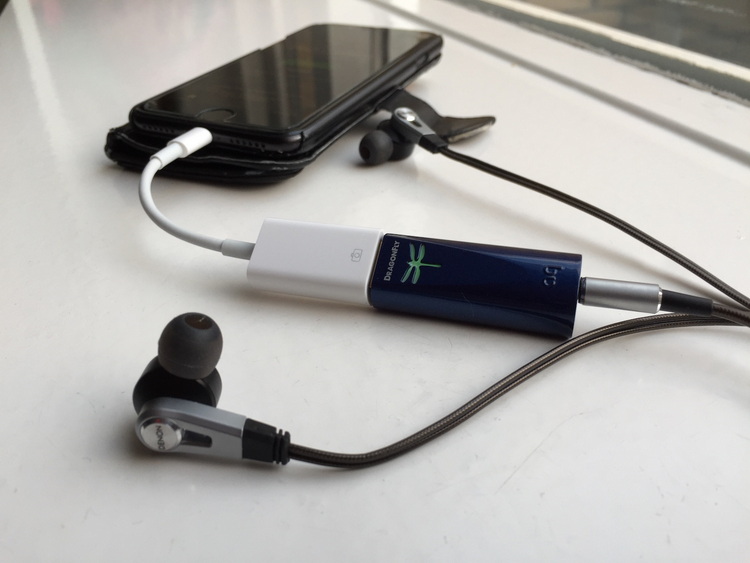
Finally, there is one more thing, and that thing is called adapter cable. Or ‘dragontail’ according to AudioQuest. Every time we put the phone in our pocket, the DragonFly Cobalt was still dangling outside. So we had to put it in the bag. This creates a bend in the adapter cable, which is subject to a fair amount of tension. An adapter cable like this cannot last a year. Wouldn’t it be great if AudioQuest develops a sleeve or cover for the most sold smartphones where you simply click a DragonFly into the cover / connector? No more hassle with cables and everything is together. Easy to take with you and no bundling or adapter cables.
Final verdict
The AudioQuest DragonFly Cobalt is a game changer that plays on a completely different level. He does not respect the established rules for mobile DACs. The DragonFly Cobalt is a d / a converter that also feels at home in a hi-fi chain. Pair the Cobalt with an amp or set of powered speakers and let the magic fill the room. We were a bit skeptical about the price, but the DragonFly Cobalt shows that it is a serious player. It is really a step above the DragonFly Red and should not be missed by the ‘mobile’ music lover. Don’t let the price put you off and have a listen!
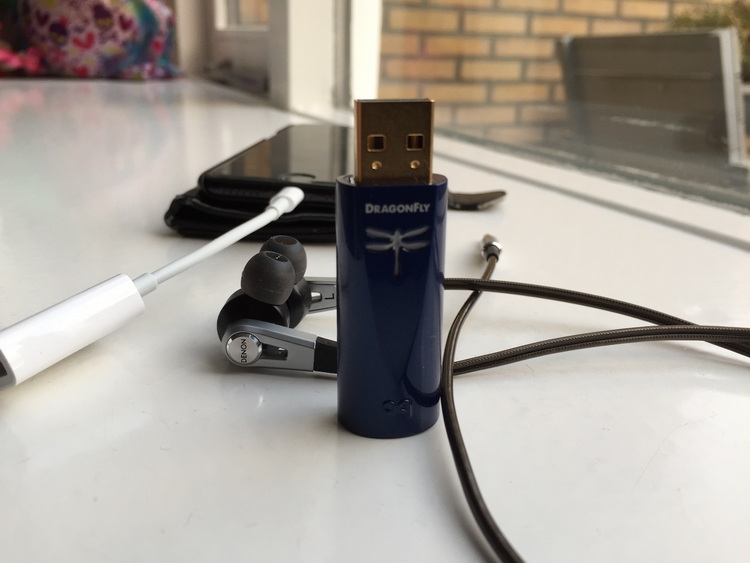
Conclusion
With a price tag of 299 euros, the AudioQuest DragonFly Cobalt knows how to create a new dimension in the field of mobile hi-fi. It turns a simple smartphone into a great-sounding mobile set. The magical blue box feels at home in a jacket or pocket, but can just as easily be connected to a system at home. The DragonFly Cobalt is a must have!
PLUS POINTS
- Display quality
- Universally applicable
- price
MINUSES
- –





